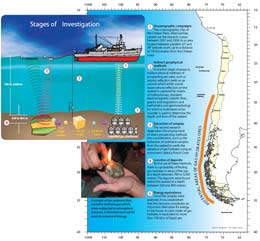
Lunes 26 de mayo de 2014
The Chilean Navy carries out a valuable contribution to the development of the country.
Some of these activities are:
- Safety in beaches and bathing resorts
- Assistance to extreme or isolated zones
- Medical Assistance Transport
- Safety in ports
- Alarm system for tidal waves
- Weather forecast
- Maritime Search and Rescue
- Maritime Instruction and Training
- Maritime aids to navigation
- Nautical Cartography
- Time signal
Furthermore, the Chilean Navy carries out a permanent contribution to the development of the country in collaboration with other state organizations as follows:
- Supervision of Fishing
(National Fishing Service)
- Control of Smuggling
(National Customs Service)
- Control of Traffic in narcotics
(Police Forces)
- Assistance to the Community
(Regional Governments)
- Aquiculture concessions
(Under – Secretary of the Navy)
- Maritime Scientific Research
(Chilean Antarctic Institute and Universities)
One of the most valuable results obtained by the work carried out by the Chilean Navy and civilian organizations was the discovery of extensive deposits of underwater gas hydrates along the coasts of Southern Chile, which represent a new source of energy for the future.
This discovery was the result of work started in 2001, as part of the project "Underwater Gas Hydrates: A New Source of Energy for the twenty-first century", which was financed by FONDEF (Foundation for Scientific Development and Technology in Chile) for the years 2002 and 2003, led by the Pontifical Catholic University of Valparaiso.
This project also includes the participation of the University of Concepcion, the Naval Research Laboratory (NRL) of the United States Maritime Department, the Hydrographic and Oceanographic Service of the Chilean Navy and European Institutions. The oceanographic ship Vidal Gormaz of the Chilean Navy has played vital role in carrying out this research.
During the first two oceanographic campaigns, carried out on board the "Vidal Gormaz" between parallels 32° and 40° latitude south, some indirect evidence of the presence of gas hydrates were found, which motivated the NRT of the United States to finance a third campaign, carried out in October 2004.
These new studies took place between the edge of the continental shelf and the start of the maritime depression at depths from 200 to 5,000 metres and up to 150 kilometres from the coast.
This time, the first physical discoveries of gas hydrates were achieved. This had great relevance for Chile, which currently depends on imports of natural gas and petroleum.
Gas hydrates have a solid form, quite similar to ice, made up of natural gas and water which are found in most oceanic beds throughout the world.
On a global scale, the two most important areas where you can find these hydrates are the sub-soils of the Arctic at a depth of several hundred metres and in the marine sediments of the continental borders, at depths from one to four kilometres as in the case in Chile where there are several areas of this continental margin.
1. Oceanographic campaigns

The oceanographic ship of the Chilean Navy Vidal Gormaz carried out the research cruises between 2001 and 2004, in an area located between parallels 32° and 40° latitude south, up to a distance of 150 kilometres from the Chilean coast.
2. Indirect geophysical methods
In the first stage of research, indirect physical methods of prospecting are used, such as seismic reflection (with an air cannon which emits sound waves whose reflection on the seabed is captured by means of hydrophones), transient electromagnetic calorific flow, gravity and magnetism, and bathymetry and geomorphology for which a multibeam echo sounder is used to determine the depth and form of the seabed.
3. Extraction of samples
The second research stage takes the employment of direct prospecting methods into consideration, such as the extraction of sediment samples from the seabed to verify the presence of gas hydrates using an instrument called a Piston Corer.
4. Location of deposits
By the use of these methods, there is a probability of finding gas hydrates in areas of the sea at a depth between 700 to 3,000 metres. The deposits were found below the seabed at a depth between 500 and 800 metres.
5. Energy equivalence
Once the samples were analysed, it was established that this resource constitutes an important alternative for energy in the future. A cubic meter of gas hydrates is equivalent to more than 100 kilos of liquid gas.
A sample of the sediment that contains methane gas which, when subjected to atmosphere pressure, is liberated and can be used as a source of energy.